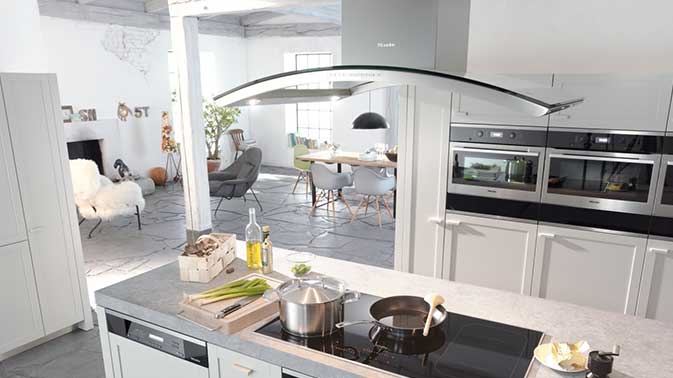KM 6388 Induction Hob

Bigger is better
Miele presents the new KM 6381 and the KM6388 - 90cm-wide induction hobs to meet the needs of the discerning cook.
For customers needing to cook on a big scale, Miele has launched the new KM 6388 and KM6381 90cm-wide induction hob. Says Mercia de Jager from Miele: “These new hob units excel in terms of their high power rating, flexibility in use, and – as the icing on the cake – they also offer the Con@ctivity 2.0 convenience function.”
PowerFlex technology
The KM 6388 (with onset stainless-steel frame) features up to five rings, four of which boast PowerFlex technology. PowerFlex rings can be linked in groups of two to create rectangular zones, facilitating for instance the use of a large casserole dish. Alternatively, individual rings can be combined to form a single large ring. This is ideal when cooking in large oversized pans.
Mercia says that another special feature of Miele’s PowerFlex technology is the extremely uniform transfer of heat to the base of pots and pans: “This is achieved through the virtually gap-free arrangement of induction coils below the ceramic glass screen. This steady transfer of energy to the food creates the ideal conditions for perfect cooking results.”
WaterBoost function
The fifth ring has a diameter of 28cm and features the WaterBoost function with a maximum output of 5.5 kW for extremely fast heating. Mercia explains: “Miele induction hobs with WaterBoost offer a maximum power level of up to 5.5 kW on a 28cm cooking zone - for pans over 24cm in diameter. Thanks to the high power level, you can heat two litres of water in two minutes and 38 seconds.”
Con@ctivity-enabled
When it comes to convenience and safety, the KM 6381 is Con@ctivity 2.0-enabled, allowing pre-emptive communication between hob and hood and letting the cooker hood know in advance what is going on down on the hob below. Says Mercia: “Information on ring settings is relayed between the two appliances and there is no need for intervention on the part of the user – the hood is switched on and off, and required suction power regulated automatically.”
The new and improved Con@ctivity 2.0 offers the same functions as its predecessor, but uses a different technology. Installation is easier to use, the system does not give rise to any additional costs and the connection between the hob and the hood is reliable and stable at all times.
DirectControl operations
The high-end features on this model hob is further complemented by DirectControl, where each ring has its own run of numbers for selecting power settings, simplifying the assignment of rings to controls. “The dial on the left is turned to select the operating mode in the traditional way. Settings in the 4 line text display, such as temperatures, can be chosen with the right hand dial and confirmed using the sensor touch controls,” explains Mercia.
The power of induction
So how does induction work? Each induction hob boasts an induction element, which is a powerful, high frequency electromagnet – the magnetic qualities of which are generated by electronics located under the hob’s ceramic surface. Induction technology requires special, ferromagnetic pots and pans – when they are placed within the magnetic field created by the hob, eddy currents disturb the field so that it transfers or “induces” energy into the metal, causing the base of the pot or pan to heat up.
Mercia elaborates: “The heat can be instantly raised or lowered by adjusting the strength of the magnetic field, so a rapidly boiling pan can reduce to a gentle simmer within approximately two seconds. The process is immediately interrupted when the pot or pan is removed from the ceramic surface.”
She says that induction cooking offers many benefits, including:
- Induction is cooking in overdrive: Power is immediately available – giving a gas-like response – thanks to the fact that no time is wasted heating the base of the pan or the glass screen. As a result, water is brought to the boil in next to no time at all.
- Supreme energy efficiency: Due to exceptionally fast heating times, induction cooking uses far less energy than other kinds of hobs. Just one example – for pasta, approximately five litres of water needs to be brought to a rolling boil. Miele’s induction hob units achieve this around twice as fast as a conventional electric hob or a gas unit. Piping hot pasta is on the table, ready for serving, considerably faster and, compared with conventional technologies, the unit requires at least 30% less energy for the same job.
- Induction hobs are easy to clean: Splashes of oil and fat cannot bake on the hob’s surface as the glass surface itself remains relatively cool. This makes cleaning your induction hob child's play.
- Super quick cool-down time: Once the pot or pan has been removed from the hob, the rings cool down so quickly that they pose virtually no risk what so ever. There is no more risk of being burnt by accidently touching an unused, but hot ring on the hob’s surface.
- Easy heat regulation: Induction hobs allow for the precise regulation of energy, which facilitates exceptional accuracy with regards to temperature control. The inconvenience of food continuing to cook once a ring has been switched off is now a thing of the past.
- Instantaneous heat: Like gas hobs, induction cooking provides instantaneous access to heat – no more waiting for the hob to warm up.
Press department
Phone: 0118759000
E-mail: marketing@miele.co.za

